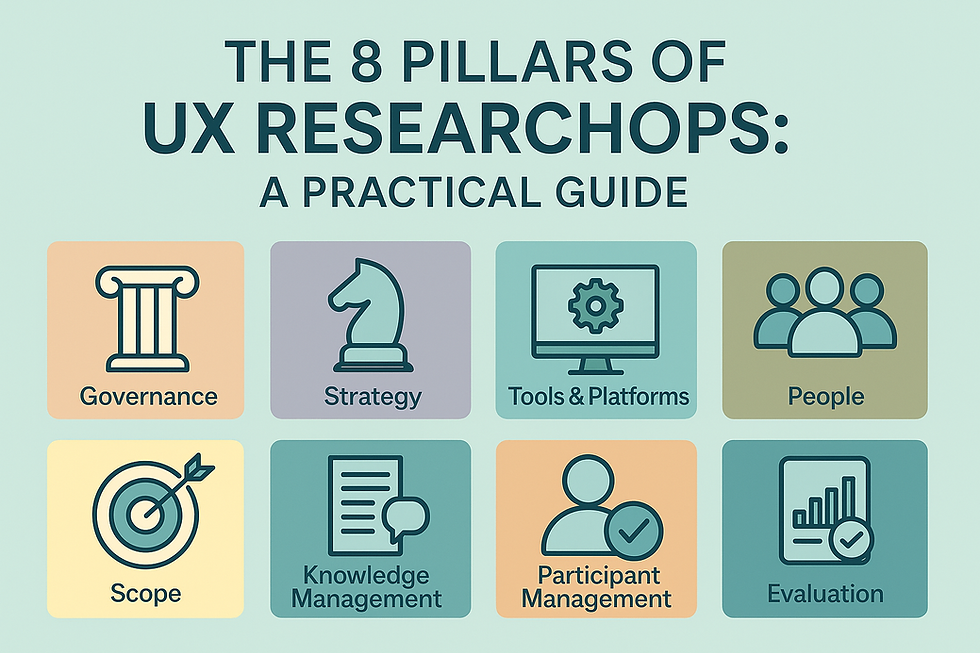Exploring the Best UX Research Platforms and Tools
- Philip Burgess
- Oct 7
- 4 min read
Updated: Oct 21
By Philip Burgess - UX Research Leader
When it comes to building a user experience that truly resonates, the tools we choose can make all the difference. Over the years, I’ve seen firsthand how the right UX research platforms can transform raw data into actionable insights. These platforms are not just about collecting information; they are about empowering teams to make smarter, data-driven decisions that elevate the entire product journey. So, what makes a UX research platform stand out? Let’s dive in.
Why UX Research Platforms Matter in Strategic UX Leadership
In the fast-paced world of digital products, organizations need more than just intuition to guide design decisions. They require robust systems that can capture user behavior, preferences, and pain points with precision. UX research platforms provide this foundation. They enable teams to:
Centralize data collection from multiple sources.
Analyze qualitative and quantitative data seamlessly.
Collaborate across departments with shared insights.
Scale research efforts efficiently as the organization grows.
From my experience, the best platforms are those that integrate smoothly into existing workflows and offer flexibility for various research methods. Whether you’re conducting usability tests, surveys, or ethnographic studies, having a reliable platform can save time and improve the quality of your findings.

Top UX Research Platforms to Consider Today
Choosing the right platform depends on your specific needs, but some tools consistently rise to the top due to their versatility and depth. Here are a few that I recommend exploring:
UserTesting - Known for its extensive panel of participants and real-time video feedback, UserTesting excels in usability testing and rapid iteration.
Lookback.io - This platform offers live user interviews and session recordings, making it ideal for qualitative research.
Optimal Workshop - Great for card sorting, tree testing, and surveys, Optimal Workshop helps uncover how users organize information.
Dovetail - A powerful tool for qualitative data analysis, Dovetail allows teams to tag, code, and synthesize research notes collaboratively.
Hotjar - If heatmaps and behavior analytics are your focus, Hotjar provides visual insights into user interactions on your site.
Each of these platforms brings unique strengths to the table. For example, if your priority is rapid feedback from real users, UserTesting might be your go-to. On the other hand, if you need to analyze large volumes of qualitative data, Dovetail could be a better fit.

What is an UX research tool?
Before we go further, it’s important to clarify what exactly an UX research tool is. Simply put, it’s any software or platform designed to help researchers gather, analyze, and interpret data about user behavior and preferences. These tools can range from survey platforms to sophisticated analytics suites.
The core purpose of these tools is to reduce guesswork. They provide evidence-based insights that inform design decisions, ensuring that products meet real user needs. UX research tools often support various methodologies, including:
Quantitative research: Surveys, analytics, A/B testing.
Qualitative research: Interviews, usability testing, diary studies.
Mixed methods: Combining both to get a fuller picture.
By leveraging these tools, organizations can build a culture of continuous learning and improvement. This is crucial for scaling UX research practices effectively.
How to Choose the Right UX Research Platform for Your Organization
Selecting a platform is not just about features; it’s about fit. Here are some practical steps I recommend when evaluating options:
Define your research goals clearly - Are you focusing on usability, user satisfaction, or behavioral analytics?
Consider your team’s workflow - Will the platform integrate with your project management and communication tools?
Evaluate scalability - Can the platform handle increasing volumes of data and users as your research program grows?
Look for collaboration features - Shared workspaces, tagging, and commenting can enhance team productivity.
Check for participant recruitment options - Some platforms offer built-in panels, which can save time.
Assess data security and compliance - Especially important for organizations handling sensitive user information.
Remember, the best platform is the one that aligns with your strategic objectives and supports your team’s way of working. Don’t hesitate to request demos or trial periods to get a hands-on feel.

Integrating UX Research Platforms into Your Workflow
Once you’ve selected a platform, the next challenge is integration. Here are some tips to ensure a smooth adoption:
Train your team thoroughly - Invest time in onboarding sessions to maximize tool usage.
Establish clear research protocols - Define how and when to use the platform for different types of studies.
Create a centralized repository - Store all research data and reports in one accessible place.
Encourage cross-functional collaboration - Share insights with product managers, designers, and developers regularly.
Measure impact - Track how research insights influence product decisions and business outcomes.
By embedding UX research platforms into your daily processes, you create a feedback loop that continuously informs and improves the user experience.
Empowering Data-Driven UX Decisions with the Right Tools
In my journey working with organizations, I’ve seen how the right ux research tools can be a game-changer. They not only streamline research but also elevate the strategic value of UX within the company. When research is accessible, actionable, and aligned with business goals, it drives innovation and delivers measurable results.
If you’re looking to build or scale your UX research practice, investing in the right platform is a critical step. It’s about more than just technology - it’s about enabling your team to uncover insights that lead to better products and happier users.
The future of UX research is bright, and with the right platforms, your organization can lead the way in creating experiences that truly matter.




Comments